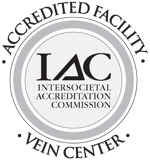Phlebitis is the inflammation of a superficial vein, often occurring in varicose veins, leading to redness, warmth, and tenderness in the affected area. Although usually self-limiting, prompt recognition and treatment are crucial to prevent potential complications. In rare cases, superficial blood clots can extend into deep veins, causing deep vein thrombosis (DVT) and increasing the risk of life-threatening pulmonary embolism.
Causes of Phlebitis
Phlebitis typically arises in individuals with venous insufficiency or varicose veins, where blood pools in the legs due to slower circulation (venous stasis). Physical injury to the leg, such as from bumping into furniture, triggers inflammation, exacerbating the condition. This combination of venous stasis and inflammation, known as Virchow’s Triad, increases the likelihood of clot formation, leading to phlebitis, especially in individuals prone to clotting.
Symptoms of Phlebitis
 Symptoms of phlebitis include a tender lump in the leg, accompanied by redness and warmth, often near a previously visible varicose vein. In some cases, a red line may appear on the inner thigh or calf, along with leg swelling. If these symptoms arise, immediate medical attention is advised.
Symptoms of phlebitis include a tender lump in the leg, accompanied by redness and warmth, often near a previously visible varicose vein. In some cases, a red line may appear on the inner thigh or calf, along with leg swelling. If these symptoms arise, immediate medical attention is advised.
Is Phlebitis an Infection?
Phlebitis associated with varicose veins is typically not an infection and does not require antibiotics. However, if infection is suspected, antibiotic treatment may be necessary as per your vascular provider’s recommendation.
Treatment Options
Treatment for phlebitis focuses on reducing inflammation, improving circulation, and monitoring clot progression. This may include:
- Ultrasound evaluation to assess vein condition
- Prescription of anti-inflammatory medications like Advil or Motrin
- Application of warm, moist compresses for 30-minute intervals multiple times daily (avoiding hot compresses)
- Wearing graduated compression stockings to reduce swelling and venous stasis
- Engaging in active walking and avoiding prolonged sitting or standing
- Elevating legs when not active
Recovery and Prevention
Phlebitis resolution can take several weeks, with potential skin discoloration lasting months. Preventive measures include addressing venous insufficiency and varicose veins through minimally invasive procedures like laser ablation, phlebectomy, and injection sclerotherapy. Additional preventive steps include maintaining a healthy weight, wearing compression stockings, staying active, quitting smoking, periodically elevating legs, and performing calf exercises during long periods of inactivity.
If you have questions or concerns relating to vein health, contact us at info@veininstitutenj.com or 973-539-6900.


.jpg)





.jpg?width=944&name=Castle-Connolly-Top-Doctors-Emblem-Large%20(4).jpg)